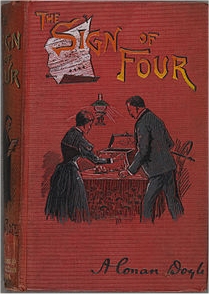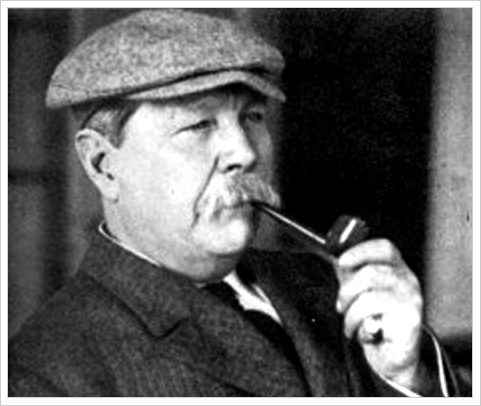Cocaine and Criminal Capers:
The Sign of the Four
By
Arthur Conan Doyle

Despite the moans of some, I think that A Study in Scarlet, the debut teaming of Mr. Sherlock Holmes and Dr. John Watson is just a little gem of perfect structure. I really enjoyed it a great deal.
A little less than three years later, Arthur Conan Doyle brought the duo back with a very different outing, in the 1890 short novel The Sign of the Four. At least for this reader, lightening didn’t strike twice.
You know, it’s only a month since I read it * and already I can’t really recall what it was all about: lots of rebellious Indian colonial stuff all right, along with the requisite murders, but apart from a very good boat chase along the Thames, not much stands out.
Well, except of course for the beginning and the end. You would hardly forget the opening, that’s for sure:
“Sherlock Holmes took his bottle from the corner of the mantelpiece, and his hypodermic syringe from its neat morocco case. With his long, white, nervous fingers he adjusted the delicate needle, and rolled back his left shirtcuff. For some little time his eyes rested thoughtfully upon the sinewy forearm and wrist, all dotted and scarred with innumerable puncture-marks. Finally, he thrust the sharp point home, pressed down the tiny piston, and sank back into the velvet-lined arm-chair with a long sigh of satisfaction.”
Apparently this wasn’t as shocking in 1890 as it reads now. And mind you, we learn from Watson that Sherlock wasn’t only a bit of a fiend for the old cocaine, but was also partial to a shedload of morphine into the bargain. How this guy ever solved anything is the real mystery in these stories.
Quite leaving aside his drug use and his annoying habit of scraping along on the violin, he must have been a right royal pain-in-the-ass to share an apartment with. Poor old Watson can’t take two steps out the door but the smartass consulting detective is examining his trousers for soil samples and telling him where he’s been. What a nightmare.
Now…my friend Anne, a long-time Holmes buff, knows that I’m a real neurotic when it comes to chronology; and hence she had me warned not to look too deeply at that side of things. A warning that I immediately ignored, leaving me a bit pissed off with this second tale.
With Scarlet I established to my own satisfaction that the main action took place in and around 1880; yet internal evidence in Four would suggest that the events of this one are in 1888. If this is only the second case then how come so many years have passed?
And it’s not as if there’s wriggle room left – well, not much – to fill in gaps with later stories, since Holmes mentions Watson’s chronicling of the first case quite early on. (True to form, he’s unhappy about it. Watson, you were either an idiot or a saint.)
And then there are those rambunctious little rapscallions, Wiggins and the Baker Street Irregulars. They’re still hanging about nearly a decade later? They must be near drawing a pension from Sherlock at this stage.
With the popularity of this series down through the decades I know that someone must have put together a timeline, but I am heroically resisting all temptation to Google one. I await with some enthusiasm the third outing in the series, in hopes that this will explain all.
And in the meantime there is a happy ending here, at least for Watson, who meets and decides to marry the lovely and charming Miss Mary Morstan, so at least he’ll be escaping to some kind of sane home life.
And as for Our Hero?
“’The division seems rather unfair,’ [Watson] remarked. ‘You have done all the work in this business. I get a wife out of it, Jones gets the credit, pray what remains for you?’
“’For me,’ said Sherlock Holmes, ‘there remains the cocaine-bottle.’ And he stretched his long white hand up for it.”
_____
* Concerning my haziness on the events of The Sign of the Four, it may be down to the fact that in between reading it and writing this I’ve also read Mervyn Peake’s extraordinary 1946 novel, Titus Groan. Of which I can only remark: Bloody Hell, did Terry Gilliam ever think of filming that?

![]()

Recent Comments